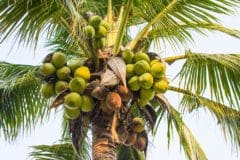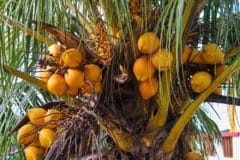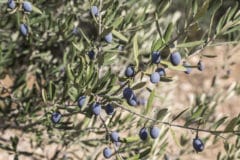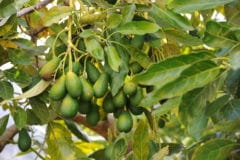Native Location Unknown
Coconut palms (Cocos nucifera) are considered a pantropical species, which means it’s found throughout tropical regions of the world. Its exact native habitat is unknown, since it’s so widely spread throughout the tropics, but it’s thought to originate in the western Pacific and Indian Ocean islands. Coconut palms are typically found in warm, humid regions located along the coast between latitudes 26 degrees south and north.
The palm is a common sight along the sandy shores of tropical islands of the world. Man is the main distributor of the palm throughout the different areas, but it also distributes itself through natural means. Dropped coconuts float for miles and wash ashore only to germinate and produce a new palm tree.
Locations in the U.S.
Not growing well in climates that are dry, coconut palms in the U.S. thrive growing along coastal regions where conditions are warm and freezing temperature don’t occur. They are tolerant to salty conditions and tolerate growing along oceans and brackish waterways. Although some desert locations might be consistently warm, the areas are typically too dry for a coconut palm.
Coconut palms are hardy growing in USDA zones 10 and 11, and in the warmest areas of zone 9, although an unexpected freeze in this zone can kill the palm. Areas of the U.S. where the palm will grow consist of south-central and southern areas of Florida, southern most areas of Texas, and southern areas of California along the coast.
Preferred Climate & Soils
Provided their climate requirements are met, coconut palms also tolerate growing in mainland areas away from the ocean shorelines and are tolerant to windy conditions. The tree’s preferred climate and soils include:
- Coconuts palms grow best with minimum temperatures of 72°F (22°C).
- Best growth takes place in locations receiving 30 to 50 inches or more of annual rainfall.
- The palm performs best in well-drained soils with a pH of 5.0 to 8.0 and tolerates areas experiencing periodic flooding.
- Coconut palms prefer sunny sites.
Commercial Production
The various products made from coconut palms are important to many economies throughout the world where the tree thrives. The vast majority of commercial planting of the palm are confined to the lowlands in the tropics. Copra, or the inner meat, is an important economical product with such things as coconut oil, various cosmetics and personal care items made from it, as well as margarine, soap and food.












